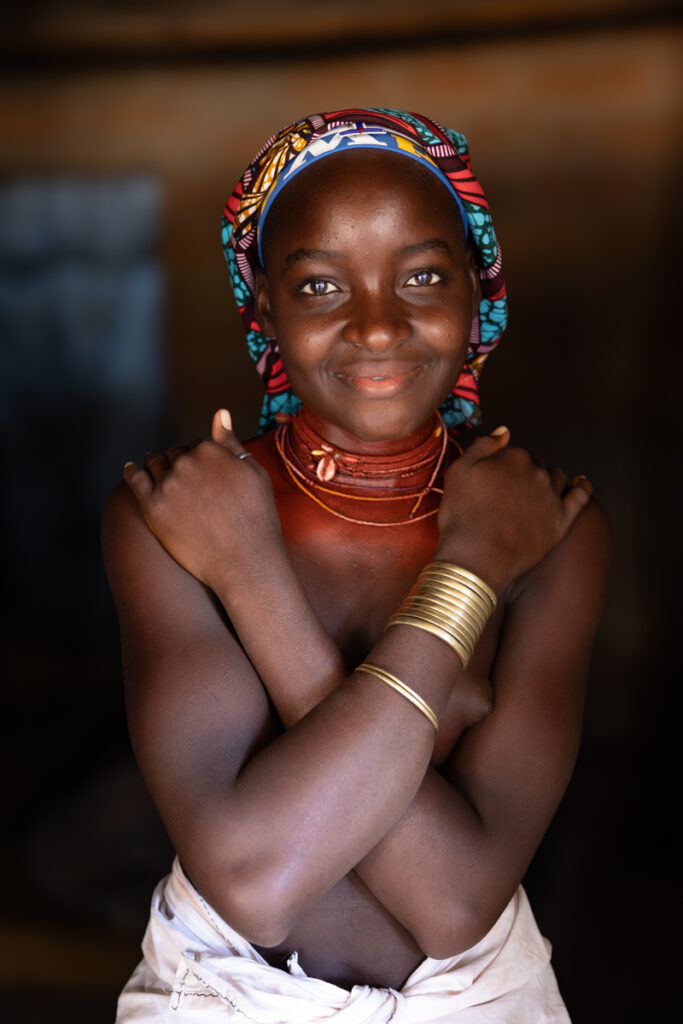Angola and Algeria – An Exposé by Ingrid Koedood
5th August 2024
Finding the right person to lead photography tours is a much harder task than many people think.
There is so much more to tour leading than just being a great photographer.
I am currently at home after four years of being constantly on the road leading tours, many of which were back to back.
About eighteen months ago I started to search for the right person to take over some of my program and within a short period of time I found that I was going to be in for a very long journey finding someone who would ‘tick all of the boxes’ and who would have the right combination of being a wonderful photographer and human, alongside having an extensive travel history, being organised and resourceful.

A beautiful elderly Ovahakaona woman with her traditional Kapopo hair decoration, signifying her status in her community (image by Ingrid Koedood)
I first began admiring the photography and travels of Ingrid Koedood a few years ago on social media. To me she always had not just a great eye, but a wonderful empathy with the people who appear in her images. When I saw that her beautiful photos came as a result of some very intense and exploratory solo travel in remote Africa and Asia, I approached her about becoming my associate.

Men and women of the Kel Azjer clan of Tuareg people march in to the annual festival of Sebiba in Djanet (image by Ingrid Koedood)
Nervous moments all round and a dashed meeting in Rotterdam later, I am proud to announce that Ingrid will be joining our Wild Images team from 2025 onwards.
In January Ingrid and I will be taking our annual tour to the incredible Voodoo Festival in Benin. Let’s hope our group don’t become confused by the two “Dutchies” leading their tour with our similar names!

An Ovahumbi woman showcasing her distinctive and intricate hairstyle affectionately known as ‘ elephant’ ears (image by Ingrid Koedood)
After that she already has quite a jammed travel program with us, and already some very excited guests joining her in the field.
Before she has even started working with Wild Images, Ingrid has travelled this year to both Angola and Algeria independently and we’ve been enthralled as she has started to post her photographs from both locations in social media.

Tuareg warrior in traditional dress ready for Sebiba (image by Ingrid Koedood)
In 2026 Ingrid will be leading our culturally comprehensive expedition to southern Angola and in 2027 she will take our incredible expedition across the Algerian Sahara, immersing our guests into the world of Tuareg culture, while exploring some of the most spectacular scenery in all of the Sahara.
I am thrilled to have Ingrid join our team.
For more information about Ingrid’s photography career, please enjoy her profile at https://www.wildimages-phototours.com/leader/ingrid-koedood/ or you can follow her on Instagram at https://www.instagram.com/ingridkoedood_photography/
~ Inger

A young Ovakuvale girl wearing her traditional Ompota headdress (image by Ingrid Koedood)

The natural beauty of Ovamwila women is distinguished by their elaborate Nontombe yellow hair braids and multi-coloured Vilanda necklaces that signify they are married. The fact that this woman was pregnant just added an extra layer to her beauty (image by Ingrid Koedood)

Tuareg men waving their Takuba swords in the air as they celebrate the ancient cultural Sebiba festival at their sacred Loggia in Djanet (image by Ingrid Koedood)

Tuareg woman, her face made up with traditional ochre and indigo, attends Sebiba wearing beautiful silver jewellery that is the trademark of Tuareg artisans (image by Ingrid Koedood)

An adorable young girl from the Ovatwa people, posing inside a modest home (image by Ingrid Koedood)

Early morning light casts a golden glow over an Ovakuvale woman in southern Angola (image by Ingrid Koedood)

In stark contrast to the past where Tuareg women were very open with their culture, these days young women and girls have become notoriously shy with photography, except at Sebiba, where you can see Tuareg women in their exquisitely beautiful traditional attire (image by Ingrid Koedood)

Portrait of a young child from the Ovatwa people, bathed in the soft glow of the morning light (image by Ingrid Koedood)

Portrait of a woman of the Ovakuvale people. She wears a string around her breast called ‘Oyonduthi’, which is used as beautification and like a bra in her culture (image by Ingrid Koedood)

A woman wearing a large Tuareg Khomaissa necklace at Sebiba. Symbolising protection, the Khomaissa usually has five triangles as the number 5 is considered a lucky number (image by Ingrid Koedood)

A beautiful young Ovakuvale woman. As a form of beautification Ovakuvale women rub ‘mupeque’ oil (reddish oil obtained from a crushed nut found in the desert) on their necks and bodies (image by Ingrid Koedood)

Smiling Romaissa wearing a silver Khomaissa to Sebiba (image by Ingrid Koedood)
